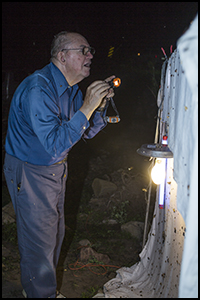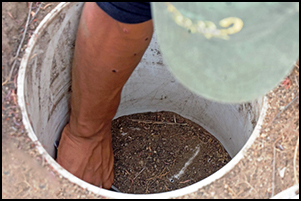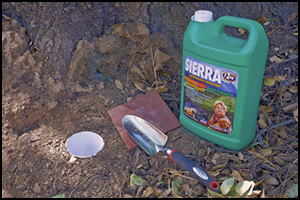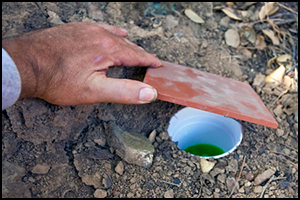Collecting Techniques
In areas where they occur, some species of solifuges can be found underneath rocks and other surface debris (including cattle dung or other large herbivore dung). Others, particularly in tropical regions, may be found on occasion under bark or within logs. A greater variety of solifuges (including psammophiles and others which don't typically shelter under rocks) can often be found foraging around bright lights at night, especially where there is conspicuous and abundant insect activity. Lights at roadside rest stops, those on commercial buildings, and even porch lights can be productive. Mercury vapor lights, powered by a portable generator and placed to illuminate a suspended white sheet (as in the photo below), can be employed where permanent light sources are not present. The solifuges often linger near the margins of the illuminated area, opportunistically grabbing prey items.

For more extensive surveys of solifuge faunas, particularly where seasonal activity data is sought, pitfall traps are effective (Muma 1975; Muma 1980). It should be noted, however, that pitfall traps intended for invertebrates can pose a significant risk to small vertebrates, such as lizards, frogs and small mammals. Design of pitfall trap arrays should take this into account. The use of "dry" traps (those without preservatives), reduces the risk to vertebrates (as long as they are constantly monitored), but may reduce the capture of solifguges, as they can climb up the sides of the traps and escape. The use of preservatives (such as propylene glycol or a propylene glycol/ethanol mix) greatly improves the yield of solifuges and other invertebrates, but can increase the death rate among vertebrates not excluded from the traps.



For short-term sampling efforts, such as weekend field trips or vists to multiple localities on a prolonged trip, plastic cups may be employed as pitfall traps. As solifuges are adept climbers, such small pitfall traps have limited value in collecting live material, unless modified for that purpose. They do work well, however for capturing material taxonomic studies if a proper preservative, such as propylene glycol or a propylene glycol/ethanol mix is employed.


A modified pitfall trap for live capture of solifuges can be constructed from a plastic cup and a clear, dome-shaped lid such as the one that accompanies "slushie"-type drinks in the United States. The dome-shaped lid, which has a central hole through which a straw is normally inserted, can be inverted and glued to the rim of the cup. A soliguge entering the trap through the hole, which now sits at the bottom of the inverted dome, is blocked from escaping when it climbs the side of the cup, as the inverted lid forms a barrier.
